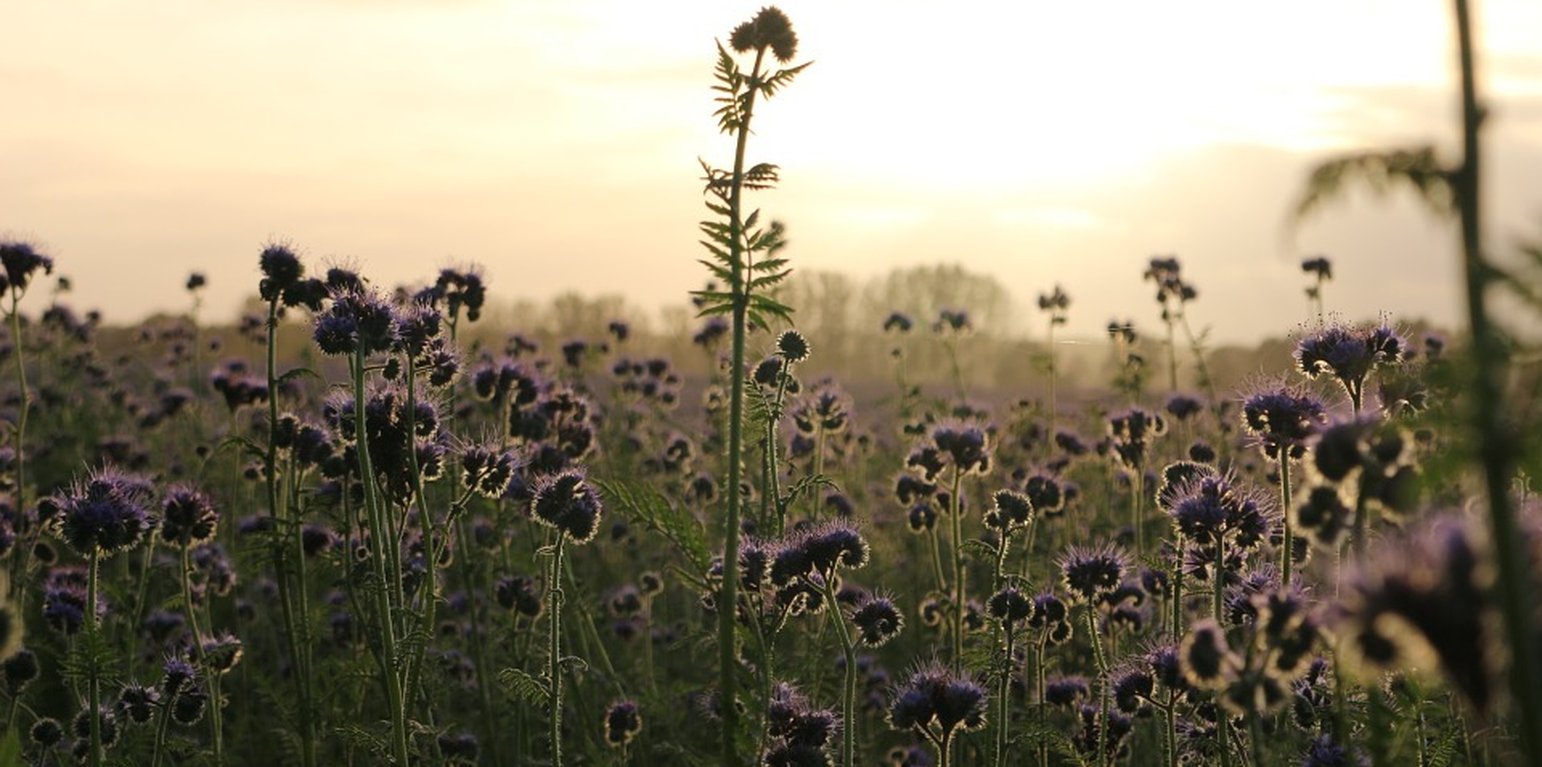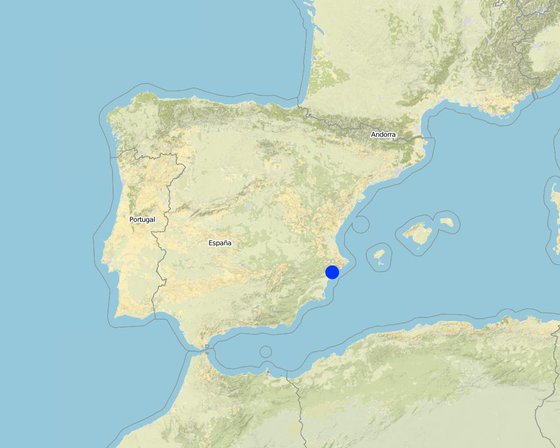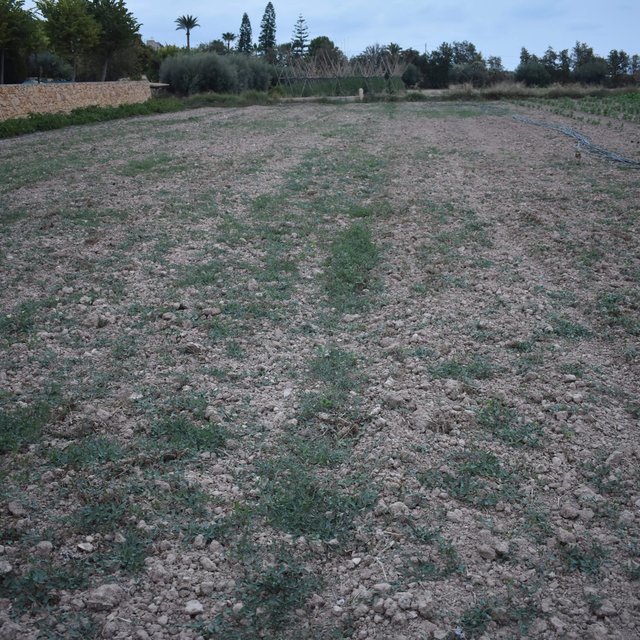



1. This sustainable land management technology was established on agricultural land in Mutxamel (region of Alicante) in the municipality of Valencia (Comunidad Valenciana), Spain. Agricultural production in this region is of a very high quality and is intensely competitive. Despite this, the region’s traditional agriculture industry is nonetheless being overtaken by other sectors, with the scarcity of water emerging as a key factor in this shift. The main orchards in this region are: citrus, lemon, almonds and olives trees, other common crops are vegetables, such as tomatoes, lettuce, etc.
2. The SLM technology focuses on annual cultivation of green manure in the form of the plant of Phacelia tanacetifolia. Phacelia tanacetifolia (Hydrophyllaceae) is commonly known as Lacy or Tancy Phacelia (syn. Purple Tancy, Fiddleneck and Valley Velvenia). Native to Californian drylands, chaparral and Central oak woodland, P. tanacetifolia has been naturalised throughout the western United States and frequently in Europe, whereas it has been extensively used as a nectar crop up and as annual green manure worldwide. Phacelia is listed as one of the top 20 honey-producing flowers for honeybees and is very rich in both nectar and pollen the lavender-coloured flowers attract bees, butterflies and other pollinating insects.
3. Initially, the main objective of the land user applying the technology was to improve the soil quality and the crop production in the vegetable fields (cabbages, tomatoes, lettuce, chards, spinach) by cultivating the Phacelia plant as an annual green manure. In other words, the maintenance of a specific cover crop such as Phacelia tanacetifolia grown in the orchard is intended to add organic matter, nitrogen, potassium and phosphorous and other nutrients coming from the decomposed manuring plant after it is worked into the soil.
4. The land user prepares the soil during September or October by ploughing the surface of soil and then sowing the Phacelia tanacetifolia seed thinly at a rate of 1 gram per square meter and within 25 cm per plant. In the examined case, the land user installed a drip irrigation system to irrigate every two to three days in autumn or every three to four days in winter. During winter time it is recommended to remove manually spontaneous plants. Before seed formation (February or March) the land user cuts the plant and then he is tilling and digging the cover crop gently into the soil, in order to incorporate all the nutrients of this green manure into the soil. It is crucial to cut the plant before seed formation; otherwise the nutrient capacity to the soil is reduced.
5. The major benefit of the intercrop of Phacelia tanacetifolia is the short term enhancement of the soil organic content. It keeps the soil more fertile during one year and therefore it has to be cultivated every year. In consequence also an improvement of the orchard productivity has been determined. Other substantial benefits are the stronger N fixation, the decrease in weeds, and the improved water-holding capacity; further to be mentioned, the better soil aggregation, as green manure crops help to improve the soil structure over time, and by this the aeration increases, and water infiltration and root growth are enhanced. Finally, the improved soil cover helps to control the risk of soil erosion.
6. One major disadvantage is the fact that Phacelia is not polyvalent. It is only an annual green manure plant, but unfortunately not also a marketable crop that could create monetary benefits in addition. Other disadvantages mentioned by the land user are the relative high establishment expenses, as for example for the irrigation equipment and as well the maintenance costs.

สถานที่: Mutxamel, Alicante, สเปน
ตำนวนการวิเคราะห์เทคโนโลยี: พื้นที่เดี่ยว
การเผยแพร่ของเทคโนโลยี: กระจายไปอย่างสม่ำเสมอในพื้นที่ (approx. < 0.1 ตร.กม.(10 เฮกตาร์))
In a permanently protected area?:
วันที่ในการดำเนินการ: 2014
ประเภทของการแนะนำ






| ปัจจัยนำเข้า | หน่วย | ปริมาณ | ค่าใช้จ่ายต่อหน่วย (euro) | ค่าใช้จ่ายทั้งหมดต่อปัจจัยนำเข้า (euro) | %ของค่าใช้จ่ายที่ก่อให้เกิดขึ้นโดยผู้ใช้ที่ดิน |
| อุปกรณ์ | |||||
| tractor | piece | 1.0 | 3300.0 | 3300.0 | 100.0 |
| manual sowing machine | piece | 1.0 | 200.0 | 200.0 | 100.0 |
| drop irrigation pipe | piece | 4.0 | 18.0 | 72.0 | 100.0 |
| weed whacker | piece | 1.0 | 14.0 | 14.0 | 100.0 |
| draw hoe | piece | 1.0 | 30.0 | 30.0 | 100.0 |
| ค่าใช้จ่ายทั้งหมดของการจัดตั้งเทคโนโลยี | 3'616.0 | ||||
| Total costs for establishment of the Technology in USD | 4'254.12 | ||||
| ปัจจัยนำเข้า | หน่วย | ปริมาณ | ค่าใช้จ่ายต่อหน่วย (euro) | ค่าใช้จ่ายทั้งหมดต่อปัจจัยนำเข้า (euro) | %ของค่าใช้จ่ายที่ก่อให้เกิดขึ้นโดยผู้ใช้ที่ดิน |
| แรงงาน | |||||
| planting | person-hour | 6.0 | 10.0 | 60.0 | 100.0 |
| remove weeds | person-hour | 24.0 | 10.0 | 240.0 | 100.0 |
| cutting plants | person-hour | 8.0 | 10.0 | 80.0 | 100.0 |
| tillage and mix the plants into soil | person-hour | 8.0 | 10.0 | 80.0 | 100.0 |
| วัสดุด้านพืช | |||||
| seed of Phacelia tanacetifolia | bag | 20.0 | 13.0 | 260.0 | 100.0 |
| อื่น ๆ | |||||
| Drop irrigation installation | person-hour | 6.0 | 10.0 | 60.0 | 100.0 |
| ค่าใช้จ่ายทั้งหมดของการบำรุงรักษาสภาพเทคโนโลยี | 780.0 | ||||
| Total costs for maintenance of the Technology in USD | 917.65 | ||||
High short term costs but low medium and long term costs expected
After green manure application less workload in medium and long term is expected.
Increasing water holding capacity of the soil is observed after green manure application.
Covering the soil with Phacelia the soil surface is covered also after harvest of the main crops.
Less soil compaction due to better soil structure and due to the green manure application.
After first anual green manure in the soil the land user observed an enhancement of nutrient content in the soil.
With Phacelia the colony of honey bees and ohter insect species has been increased during the flowering period.
Honey bees are attracted to flowers for the pollen of Phacelia before cut the plant in seeding process formation.
No pollution by herbicides/pesticides.
Green manure or vegetation cover reduced greenhouse gas emissions.